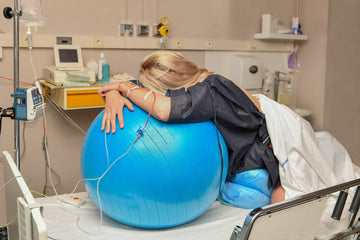10 Common Complications of Labor

The term ‘Complications’ umbrellas so many possibilities when it comes to labor. As a mother, giving birth is already scary enough, but if you hear the doctor label your labor it can mentally throw you off and hinder your birth plan. While there are several causes for true complications, most of the time the terms thrown around are just that: words.
The problem is that these words tend to then dictate the rest of the labor and possibly cause a real complication – known as the ‘domino effect.' To avoid any unnecessary stress or interventions, the best thing you can do is understand what constitutes a true complication. I have compiled a list of terms that are used and what the stand for; I’m also including options and natural ways to avoid interventions if any of these ‘complications’ arise during your labor.

10 Complications of Labor
Overdue: Labor is not a predictable science. It is not supposed to be. A due date is an estimation and should be a “due month” with a four-week window (38-42 weeks). Your baby needs time to grow and develop and should not be taken any earlier than is needed. Being 40 weeks and 1 day does not mean you are passed your due date, or that baby is done and ready! The average gestation is 41 weeks and 1 day. Do not feel pressure to be induced; a placenta typically has a lifespan of 44 weeks or longer, if healthy. Stay hydrated to keep amniotic fluid levels in the normal range and relax as much as possible. You will go into labor when it is time.
Group B Strep: Research and make an educated decision that is right for you on whether or not to accept the antibiotics. If you deny antibiotics (which you are able to do), make sure that your birth team watches for signs of GBS in your newborn. If you accept, make sure to keep your gut healthy in preparation for labor.
PROM (Premature Rupture of Membranes): This is when the water breaks before the onset of labor - when you are at least 37 weeks along. Most birth locations require birth to occur within 24 hours of water breaking. Talk to your doctor or midwife about practice policy and if the situation occurs, don’t look at the clock the moment your water breaks. It is not an emergent moment that requires an exact time stamp. Waiting until contractions start and progress into active labor is the best time to start contacting your birth team. Read more about PROM HERE.
AROM (Artificial Rupture of Membranes): This term may be used when trying to speed up your labor. There is generally no need to speed labor up, nor a need to break your water. While it may speed things up, perhaps your baby needed the extra time, or even your own body needed it? There is also the chance that AROM leads to further interventions such as Pitocin or even a C-section. And having your baby born in the caul (in her sac of water) would be pretty fantastic.
OP (Occiput Posterior): This defines a baby’s position who is “sunny-side up” – or looking up instead toward your back. This position often causes very intense back labor but is not reason for any emergent intervention. OP births are typically longer than LOA or ROA (left or right occiput anterior) births because baby needs more time to properly get down the birth canal and enter the world.
Breech: This refers to a baby who is feet or bottom down. Most birth teams will not vaginally deliver a breech baby and say that it is need for a surgical birth. However, it is not actually dangerous when a knowledgeable birth team is involved, and it is realistically not cause for intervention. Finding a doctor or midwife to aid in a vaginal delivery may be challenging, but it is possible. Breech births require a hands-off delivery, as you should not pull on the baby at all. Some babies will turn in labor, so a scheduled c-section is not needed. Wait for labor to start naturally and request an ultrasound during active labor before agreeing to a surgical birth.
Transverse Lie: This is when the baby has positioned himself horizontal, across the uterus instead of head down. While most transverse babies turn in labor, there is a chance the baby will not. This IS cause for immediate intervention. Cesarean sections save mothers and babies in this situation.
TVP (Transverse Vertex Presentation): This means that the baby’s head is sideways and typically occurs when the baby is changing positions from OP to LOA. When in labor, baby should safely turn correctly, BUT an ultrasound is needed to ensure proper placement. A cesarean section will be needed if baby does not turn.
Precipitous Labor (FAST Labor): Your birth team may recommend an immediate epidural to slow things down and get control of labor. If there is time for an epidural, it may stall your labor and then domino into needing Pitocin or other interventions. While a fast labor is intense (VERY intense), it is not need for intervention. Read more about precipitous labor HERE.
Prodromal Labor (SLOW Labor): A longer than average labor that can last days (possibly weeks for some). Typically, prodromal labor starts and stops, leaving the mother frustrated. This type of labor, while hard and long, is not need for intervention. Read more about prodromal labor HERE.
Taking a pregnancy and birthing class and reading about labor can help you to better understand your body, birth, and what to expect.







